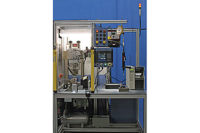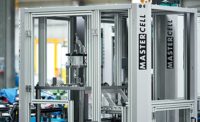Rotary indexing dials have been a mainstay of automation systems for decades. They are simple, inexpensive, precise, reliable and durable. What’s more, they can assemble a lot of product in a relatively small footprint and with a minimal number of parts fixtures.
"Rotary assembly machines are fast and dependable," observes Kim Stemler, sales manager at Merritech Assembly and Test Systems (Saginaw, MI). "We’ve built machines that have been operating 15, 20 years and never needed a service call."
Yet despite their advantages, rotary indexing dials have lost ground to other automated assembly platforms in recent years. Manufacturing engineers point out that the throughput of a dial is limited by its slowest operation, and a problem at any station stops the entire machine. Another common complaint is that access to the machine and its stations is limited.
Stemler also blames the "F word"—flexibility—for the lessening popularity of dial assembly chassis. "Our rotary business was stronger 5 years ago," he says. "Companies have gone more to palletized assembly systems, which are a lot more flexible."
However, assemblers may want to give rotary indexing dials a second look. Machine builders have used new control technologies and some creative engineering to overcome the old limitations of dial systems. Assemblers may find that today’s rotary dials are more flexible than they once thought.
Sizes and Speeds
The size of a rotary indexing dial depends on the product to be assembled and the number and type of stations needed to assemble it. For automated assembly applications, dials range in size from 18 to 100 inches in diameter.A 30-inch dial can typically accommodate 16 stations, or one station every 22.5 degrees, says David W. Duemler, technical director of Demco Automation (Quakertown, PA). "That gives you a pretty good spread around the stations," he says. "It’s not too cramped, but it’s not too big, either."
Production rates with rotary dial systems vary, and each system’s index time will be limited by the slowest process on the dial, says Julie Logothetis, president of Kahle Engineering Corp. (Summit, NJ). For a simple product with a few small parts, the rate might be 60 to 80 assemblies per minute. For a more complex product, a rate of 30 to 40 assemblies per minute is typical.
"That’s on par with other assembly chassis, but it depends on the application," says Logothetis. "With medical products, for example, we have to be conservative with cycle time, because the parts are so delicate."
"Compared with other automation platforms, dials are quicker," adds Duemler. "You don’t have to wait for pallets to move in and out of each station."
Products assembled on rotary indexing dials are small. Most fit inside a 6-inch cube and have less than 15 parts. Ideally, the product’s parts should be assembled from above, with simple up and down motions. "If you have to put in pieces from oblique angles, rotary machines don’t work very well," explains Stemler.
Products with long, highly flexible components, such as tubing, should not be assembled on dials. "It’s difficult to handle the tube and keep it out of the way of the mechanisms," says Duemler.
Most assembly operations can be performed on a dial, including pick-and-place, screwdriving, crimping, pressing, labeling, ultrasonic and resistance welding, dispensing, and infrared and ultraviolet curing. SCARA robots, machine vision systems and electrical testing can be incorporated into dials, and products that require micron-level placement accuracy can be assembled on dials.
"You can do almost anything on a dial except for things like adhesives with long cure times or testing with long wait times," says Duemler. "Processes on a dial should take seconds, not minutes. The goal is to have all the processes as close together in time as possible."
Of course, engineers need not incorporate all assembly and test processes onto one dial. A product that is assembled in 10 steps could be manufactured on a 10-station dial; a pair of five-station dials; a four-station dial and a six-station in-line system; or any other combination that makes sense economically. "If you want to stay on one table, you only have so many stations to work with," Logothetis points out. "With a linear system, you can add as many stations as you want, because each is an independent machine."
Dials Get Flexible
In a traditional rotary indexing dial system, the motion of the assembly stations is produced by cams connected to a central Geneva drive by horizontal shafts and bevel gears. Additional movements are carried out by pneumatic elements, which are also controlled by the central drive, or by a vertically oscillating central shaft.To provide a long dwell time and a short index time, a clutch brake can be added to the central drive. The clutch brake disconnects the motor from the indexer during the dwell and reconnects it on a signal. This construction avoids cam designs with extreme accelerations and decelerations.
Because changing a part or a process usually means changing multiple cams, cam-driven machines are best reserved for assembling stable products in high volumes. "We built a rotary machine to assemble spray nozzles for outdoor misters," says Stemler. "That product is not going to change for the next 20 years, so the company invested in a hard-tooled dial machine."
Thanks to improvements in the size, cost and power of microprocessors, as well as the development of high-speed networking systems, such as Ethernet and Devicenet, rotary indexing dials no longer have to be controlled by cams. Indeed, these technologies have enabled machine builders to offer standard base machines with intelligent, preconfigured, "plug-and-play" processing stations. This increases the flexibility of the machine and reduces development time for both hardware and software.
For example, Demco’s Wedge system consists of preconfigured workstations that slide interchangeably into standard rotary or linear base machines. The base machine is run by a small PLC, which doesn’t control the stations, but rather acts as a traffic cop, coordinating their activity.
"If you decide to add an inspection station between two stations, you slide the stations out, move them over one, and slide them back in," says Duemler.
Manufacturers can swap out all the stations and assemble a completely different product. Or, assemblers can get a machine with twice as many stations as they need, to give themselves capacity to grow. If demand increases, existing stations can simply be replicated and plugged into the base. And because each workstation is controlled by its own microprocessor, it can operate independently on a benchtop. This gives assemblers time to fine-tune processes off-line while waiting for production volume to increase.
Distributed control also facilitates programming and debugging. "Normally, automated assembly systems are controlled by one large piece of PLC code. If you change the program for one station, you affect something else in the program," Duemler explains. "With distributed control, you only have to modify the code for that particular station. That’s a huge advantage if you’re assembling something like medical devices, with all the analysis that goes into proving the machine is reliable and predictable. You can make a change without revalidating the entire machine."


